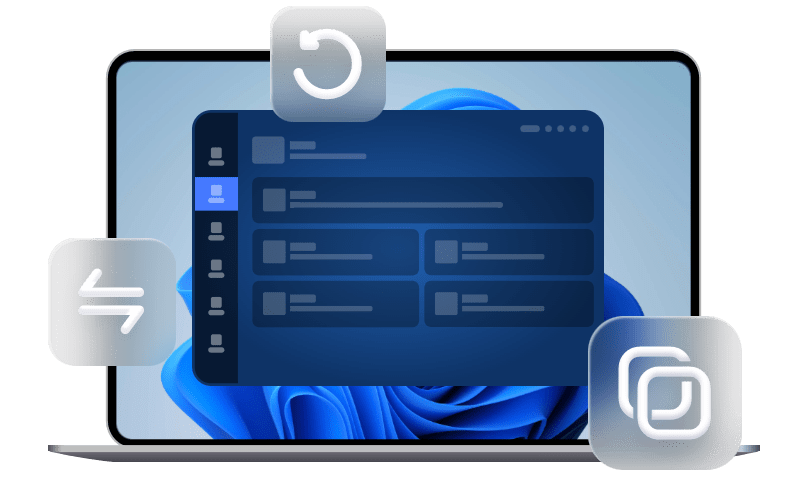Windows 10 End of Support: What Happens & What to Do?
Read through this blog to learn everything about Windows 10 end of support. It covers Windows 10 support end dates of all versions and what to do for W10 end of life. Scroll down to get the detailed information.
Windows 10 End of Support Countdown
Windows 10 has been a reliable operating system for millions of users worldwide since its launch in 2015. But as all good things come to an end, so does Microsoft's support for Windows 10. Microsoft officially announced that Windows 10's end of support will occur on October 14, 2025.
If you're wondering: What does Win 10 end of life mean? Can we still use Windows 10 after 2025? Windows 10 end of support, what to do? Then you are in the right place. This post will provide you with everything you need to know about Windows 10 end of life, including what to do, Windows 10 end of support extended, upgrading to Windows 11, etc.
Windows 10 End of Support Date
Windows 10 End of Life(EOL) means that Microsoft will no longer provide free technical support, security fixes, software updates, or new feature updates for the Windows 10 operating system. The final version of Windows 10, 22H2, will be the last. And before Microsoft stops supporting for Windows 10, the following Windows 10 editions will continue to receive monthly security updates until the final date - October 14, 2025:
- Windows 10 Home
- Windows 10 Pro
- Windows 10 Pro Education
- Windows 10 Pro for Workstations
- Windows 10 Education
- Windows 10 Enterprise
- Windows 10 IoT Enterprise
- Windows 10 Team
- Notes: Windows 10 Long Term Service Channel (LTSC) editions are not included in the date of end of life for Windows 10. That is, these LTSC editions will receive updates based on their lifecycle after this date.
What Happens When Windows 10 Support Ends?
The support for Windows 10 ends doesn't mean Windows 10 will vanish. However, continuing to use it comes with some drawbacks and risks:
- No Security Updates: Your system will no longer receive patches for newly discovered vulnerabilities. That means any malware or security flaw found after the Windows 10 EOL date could pose a serious risk.
- No Technical Support: Microsoft won’t offer customer support, making troubleshooting issues harder.
- Software Compatibility: New applications may no longer support Windows 10, and updates for existing apps could fail. This will gradually affect your system's usability.
- Declining Performance and Reliability: Windows 10 will fall behind in terms of functionality, speed, and efficiency as time goes on and new updates for Windows 11 and later are developed.
- Compliance Risks: For businesses, using outdated systems may violate compliance requirements, leading to potential legal consequences.
What to Do for Windows 10 End of Support?
Facing the Windows 10 end of support, there are 5 main options to choose from. Check them one by one now.
Option 1. Upgrade Windows 10 to Windows 11
Upgrading to Windows 11 is the most straightforward solution. It allows you to access new features and security updates, get improved performance and stability, and enjoy fresh UI and productivity tools like Snap Layouts and virtual desktops and integration with AI-powered tools.
But before proceeding with the upgrade, please make sure that your computer meets the minimum system requirements for Windows 11:
✅ 1 GHz or faster CPU with 2 or more cores on a compatible 64-bit processor
✅ 4 GB RAM
✅ 64 GB or more storage
✅ TPM version 2.0
✅ UEFI firmware and Secure Boot capability
✅ DirectX 12 compatible graphics
If your computer does not meet the Windows 11 minimum system requirements, you may need to get a new eligible device to continue using the system. If your current device is eligible, you can follow the steps below to perform a Windows 11 upgrade easily:
Step 1. Use the PC Health Check tool to verify compatibility.
Step 2. Go to Settings > Update & Security.
Step 3. On the Windows Update screen, click on Check for updates to get the Windows 11 upgrades.
Step 4. Then, click on Download and Install and follow the instructions to install.
- ★Notes:
- Please always keep your Windows system updates after upgrading to Windows 11, because Windows 11 ends support for old versions as well. For instance, Windows 11 ends of life for versions 21H2 and 22H2 on October 10, 2023, and October 8, 2024, respectively.
- If your Windows 11 update failed to install or being stuck, you can run the Windows Update troubleshooter or download and install the updates manually from Microsoft's official website.
Option 2. Buy Windows 10 Extended Security Updates (ESU)
For businesses and some users who can't upgrade immediately, Microsoft will offer Extended Security Updates. The ESU program offers paid access to important and critical security updates for devices after the end of support for Windows 10. It does not include new features, non-security updates, or technical support. The program is available for up to 3 years, with pricing and availability varying based on user type.
Some common versions of Windows 10 extended support end dates, like Windows 10 Pro end of life and Windows 10 Enterprise end of life, and prices are listed below.
|
Coverage Length |
Windows 10 Pro |
Windows 10 Enterprise |
|
Year 1 (2025-2026) |
$61 per device |
$47 per device |
|
Year 2 (2026-2027) |
$122 per device |
$94 per device |
|
Year 3 (2027-2028) |
$244 per device |
$188 per device |
Option 3. Switch to Other Alternative Systems
If you don't want to continue using the Windows system, you can choose to switch to another operating system. For example:
- Linux Distributions like Ubuntu, Fedora, or Linux Mint; they are open-source and free, customizable with wide community support, and have low system requirements.
- Chrome OS Flex for lightweight, web-based tasks.
- macOS if you plan to invest in Apple hardware.
Option 4. Continue Using Windows 10
Continuing with Windows 10 after support ends may seem harmless in the short term, but it also carries long-term risks. The potential risks includes:
- Increased vulnerability to malware and ransomware
- Compatibility issues with new applications and hardware
- Lack of support from antivirus software or browsers over time
If you choose to continue using Windows 10 after the lifecycle of Windows 10, keep the following tips in mind to avoid cyber attacks and other system errors:
- Install a strong antivirus with frequent definition updates
- Avoid suspicious downloads
- Avoid using it for sensitive tasks like online banking or storing critical data
- Disconnect from the internet if using it for isolated tasks
- Consider virtualization or sandboxing for added protection
Option 5. Backup Your Windows 10 Computer for Data Security
Regardless of what path you choose, backing up your computer is crucial before the Windows 10 end of support date. It helps prevent data loss during system upgrades as well as against hardware failure or ransomware, allowing you to restore computer to an earlier date in case something goes wrong.
AOMEI Backupper Standard is a free, powerful Windows backup tool that simplifies data backups. Working widely on Windows 10/11 and all other Windows systems, this software comes with various backup features:

- System/Disk/Partition/File Backup - You can backup the operating system, hard drives, specific partitions, or some files and folders per your need.
- Diverse Storage Devices - External hard drives, USB drives, SD cards, network drives, NAS, and cloud storage are supported for data backup.
- Automatic Backup - It offers 5 auto backup modes to keep your data up-to-date effortlessly, including daily, weekly, monthly, USB plug in, and event triggers.
- Bootable Media Creation - It enables you to create bootable media to boot computer and restore even if the system crashes.
Download and open AOMEI Backupper Standard on your Windows 10 computer, go to Backup > choose the target backup type (e.g., System Backup, Disk Backup, or File Backup) > choose an external drive, USB, or network location to start the backup process.
FAQs about Windows 10 End of Support
#1. When does Windows 10 support end?
The last supported version (22H2) reaches its end on October 14, 2025. Earlier versions have already hit their end-of-life milestones.
#2. Can I use Windows 10 after the end of life?
Yes, but it’s not recommended due to security and compatibility issues. You’d be using an unsupported and potentially unsafe system.
#3. Can I upgrade my Windows 10 to 11 for free?
Yes, eligible users with genuine licenses can upgrade for free. Use the PC Health Check tool to see if your system qualifies.
#4. Do I have to buy a new computer for Windows 11?
Not necessarily. If your current PC meets Windows 11's requirements, a hardware upgrade isn’t needed. However, older systems without TPM 2.0 or Secure Boot may require the purchase of new hardware.
#5. Is Windows 11 better than Windows 10?
Windows 11 offers better security, user interface, multitasking tools, and system performance. While some users prefer the familiarity of Windows 10, Windows 11 is optimized for modern computing and is expected to receive support well into the future.
Conclusion
On this page, we have discussed the issue of Windows 10 end of support, including the end date, and provided a full guide about what to do when Microsoft ends support for the Windows 10 system. Whether you choose to upgrade to a new system, switch to an alternative OS, or keep using the Windows 10 system, it is always recommended to back up your important data using the professional yet free Windows backup tool - AOMEI Backupper Standard, which helps you keep Windows 10 after October 2025.
With this software, you can create backup images for the Windows system or individual files to a USB drive and other various paths. If you want to protect multiple computers within your company, please try the AOMEI Backupper Technician or Technician Plus version.

